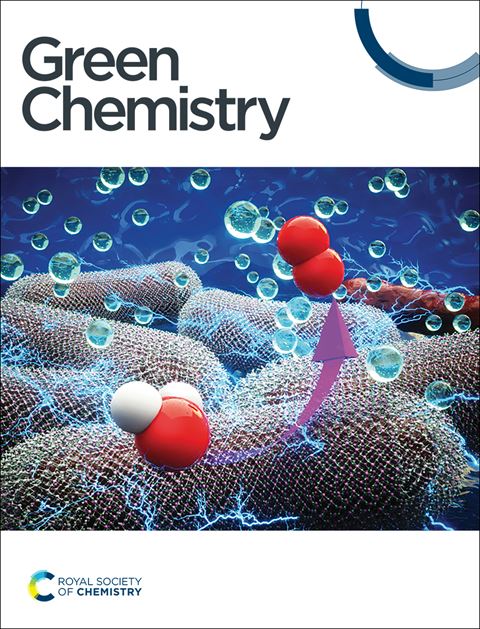设计谷氨酸棒状杆菌和共固定化酶的杂交系统,用于从甘油†中高效生产尸胺
IF 9.2
1区 化学
Q1 CHEMISTRY, MULTIDISCIPLINARY
引用次数: 0
摘要
1,5-二氨基戊烷(尸胺)是生产生物基聚酰胺的重要原料。随着人们对化石资源枯竭的日益关注和对可持续工业解决方案的需求不断增加,尸胺的生物合成引起了人们的极大关注。目前,尸体碱的从头生物合成主要使用葡萄糖作为底物,但高成本破坏了其与其他生物材料的竞争优势,需要新的生产路线。在这里,一个细胞工厂与共固定化酶结合,以甘油为唯一的碳源生产尸胺。谷氨酸棒状杆菌首先被改造成从甘油中生产赖氨酸。随后,通过调节赖氨酸生物合成途径和增强还原供电途径,对初始菌株CGgly2进行工程化。优化发酵参数后,重组菌株LYS10在摇瓶培养中赖氨酸产量达到19.0 g L−1。为了有效地转化尸胺,采用“乙酰化”策略来设计赖氨酸脱羧酶。此外,用环氧树脂将工程酶与5′-磷酸吡哆醛(pyridoxal 5′-phosphate, PLP)共固定,得到酶配合物ER604-10EK-PLP,该酶配合物的催化活性和稳定性显著增强。最终,菌株LYS10与配合物er604 - 10eb - plp在5 L发酵罐中结合,通过补料分批发酵积累了90.7 g L−1尸胺,产率为0.2 g g−1甘油,这是甘油中尸胺的最高滴度。这种混合平台有望实现尸胺的可持续生产,为化石衍生化学品提供了一种可行的替代品。本文章由计算机程序翻译,如有差异,请以英文原文为准。
Engineering a hybrid system of Corynebacterium glutamicum and co-immobilized enzymes for efficient cadaverine production from glycerol†
1,5-Diaminopentane (cadaverine) is a critical raw material for producing bio-based polyamides. With growing concerns about the depletion of fossil resources and the increasing demand for sustainable industrial solutions, the biosynthesis of cadaverine has attracted significant attention. Currently, the de novo biosynthesis of cadaverine primarily uses glucose as the substrate, but high costs undermine its competitive advantage against other biomaterials, requiring novel production routes. Here, a cell factory coupled with co-immobilized enzymes was employed to produce cadaverine using glycerol as the sole carbon source. Corynebacterium glutamicum was first engineered to produce lysine from glycerol. Subsequently, the initial strain CGgly2 was engineered by regulating the lysine biosynthetic pathway and enhancing the reducing power supply pathway. The lysine yield of recombinant strain LYS10 reached 19.0 g L−1 in shake flask cultures after optimizing fermentation parameters. For efficient bioconversion of cadaverine, an “EKylation” strategy was employed to engineer lysine decarboxylase. Besides, the engineered enzyme was co-immobilized with pyridoxal 5′-phosphate (PLP) using epoxy resin, resulting in the enzyme complex ER604-10EK-PLP, which exhibited significantly enhanced catalytic activity and stability. Ultimately, strain LYS10 was combined with complex ER604-10EK-PLP in a 5 L fermenter, and 90.7 g L−1 cadaverine was accumulated via fed-batch fermentation with a yield of 0.2 g g−1 glycerol, which was the highest titer of cadaverine reported from glycerol. This hybrid platform is promising for sustainable production of cadaverine, offering a viable alternative to fossil-derived chemicals.
求助全文
通过发布文献求助,成功后即可免费获取论文全文。
去求助
来源期刊

Green Chemistry
化学-化学综合
CiteScore
16.10
自引率
7.10%
发文量
677
审稿时长
1.4 months
期刊介绍:
Green Chemistry is a journal that provides a unique forum for the publication of innovative research on the development of alternative green and sustainable technologies. The scope of Green Chemistry is based on the definition proposed by Anastas and Warner (Green Chemistry: Theory and Practice, P T Anastas and J C Warner, Oxford University Press, Oxford, 1998), which defines green chemistry as the utilisation of a set of principles that reduces or eliminates the use or generation of hazardous substances in the design, manufacture and application of chemical products. Green Chemistry aims to reduce the environmental impact of the chemical enterprise by developing a technology base that is inherently non-toxic to living things and the environment. The journal welcomes submissions on all aspects of research relating to this endeavor and publishes original and significant cutting-edge research that is likely to be of wide general appeal. For a work to be published, it must present a significant advance in green chemistry, including a comparison with existing methods and a demonstration of advantages over those methods.
 求助内容:
求助内容: 应助结果提醒方式:
应助结果提醒方式:


